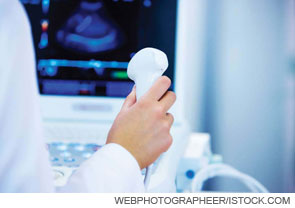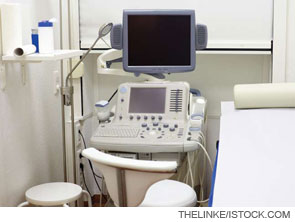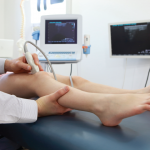
The uses of ultrasound (US) technology in rheumatology have been growing in importance over the last few years. Many rheumatologists are beginning to explore the possibility of adding US to their practices.
“Ultrasound is becoming the state of the art in diagnosis and treatment in the United States,” says Jonathan Samuels, MD, assistant professor of medicine in the division of rheumatology at the New York University Hospital for Joint Diseases in New York City. “It is now considered by many to be a part of our physical examination, like a rheumatologist’s other stethoscope.”
With this technology, physicians can “see” inside the joint in real time and find indications of active inflammation or fluid—indicators that are often hard to find by palpation or visual assessment alone. There are also dynamic applications that allow physicians to assess a joint during movement. This is not possible using static modalities such as magnetic resonance imaging or computed tomography scans.
Diagnostic Uses
“From the diagnostic perspective, you are able to do a lot of things as a rheumatologist that you would not feel as comfortable doing, or do as well, without it,” says Eugene Kissin, MD, associate professor of medicine at Boston University. “Sometimes we get a patient with joint pain, but nothing is found on the initial examination. It is nice to be able to see within minutes if, in fact, there is inflammation.”
US is also finding more uses in helping physicians make treatment decisions. Dr. Kissin points to the patient who seems to be doing well and may be a candidate for lowering or even stopping medications. The images from the US could show subclinical activity resulting in a reevaluation of that decision.
“In one study of people presenting with ankle pain, an ultrasound was performed after the participating rheumatologists had completed their routine examination and had formulated a care plan,” he says.1 “Most of the time, the additional information from the study caused revisions in the plan of care.”
US in Treatment
After the plans are in place, US is proving helpful during treatment. Real-time guidance of needle placement for aspiration and medication administration allows the physician to be more confident that the needle is in the exact place it needs to be.
“There are certain joints that are very hard to find using palpation,” says Dr. Kissin. “For example, most rheumatologists won’t inject hip joints. These are fairly easy to inject with guidance from ultrasound.”
There are a number of studies suggesting that increased blood flow to a joint as measured by ultrasound is predictive of future damage. In addition to diagnosis and treatment, US may also be useful in developing a prognosis.
The next question for most physicians would be: Why should I consider getting my own machine? Why not just send patients to a nearby imaging center?
ACR Responds to Members’ Questions About Ultrasound Use
- Should a rheumatologist use ultrasound?
- Does ultrasound improve patient outcomes?
- What is appropriate use; what is inappropriate use?
- How much training is needed to effectively perform and make a clinical diagnose using ultrasound?
- Should ultrasound certification be required?
- Should ultrasound training be incorporated into the fellowship curriculum?
- Is ultrasound only used to boost practice revenue?
- What does the research say about ultrasound?
- How many rheumatologists are using ultrasound?
- Is ultrasound reimbursement an issue?
With ultrasound’s growing presence in rheumatology, these are just a few of the questions the ACR leadership sought to answer when they invited members with varying ultrasound expertise to participate in a Task Force last August.
The Task Force surveyed the membership, commissioned a job task analysis study, evaluated the needs of training programs, explored partnership opportunities, studied other musculoskeletal certification models and educational courses, and investigated the feasibility of the ACR offering a certification program.
The preliminary Task Force report indicated the need for more educational opportunities and mentors. In response, the ACR expanded its ultrasound beginner courses, and plans are underway to offer an intermediate course with a cadaver workshop and a train-the-trainer program in 2012. The next ACR Musculoskeletal Ultrasound Course for Rheumatologists will be held as an annual meeting preconference course on November 4–5 in Chicago.
The Task Force’s final report, which will address certification, will be presented to the ACR board of directors in August. The findings of the report will also be published on the ACR’s website, www.rheumatology.org.
Coding changes and payment concerns related to ultrasound use are being closely monitored by the ACR’s coding staff. Practitioners that experience any issues with payment should contact Cindy Gutierrez, practice management specialist, at (404) 633-3777, ext. 310.
Advantages of an In-office Unit
“With office-based ultrasound we can get needed information instantly,” says Dr. Samuels. “You don’t have to inconvenience the patient, and yourself, by stopping the examination, sending them elsewhere, waiting for the results, and then having the patient come back a few days later.”
The experts point to the added advantage of establishing a better rapport with the patient. It also can be used as patient-teaching opportunity.
“The patients really like one-stop service,” notes Dr. Kissin. “They can see for themselves the pathology that you are evaluating, giving them greater confidence that the treatment was accurate and appropriate.”
Costs to the Practice
The initial costs of acquiring an ultrasound machine for a practice will range from as low as $30,000 to nearly $200,000, based largely on the resolution required. Both Drs. Samuels and Kissin do not think the higher-priced machine is needed in rheumatology practices.
“Ten years ago, the differences in image quality between the low- and high-end machines was dramatic,” says Dr. Kissin. “Now there is only a small difference in resolution. A rheumatologist can obtain all the information they need to make decisions with a cheaper, portable machine.”
In addition, the amount of cash that is required up front is based on buying the machine outright. A lease may fit into the practice’s cash flow easier.
The ongoing costs are very small. Mostly it will be for inexpensive consumables like the conductive gel and cleaning the probes between patients.
Training Considerations
If you decide to purchase an US machine for your practice, the next step will be to get the training needed to properly operate the machine and read the images. The initial instruction is available from many sources, including the ACR, academic medical centers, private education companies and US manufacturers. Most are a weekend in length. However, this is usually only the start of the process.
“How fast a person gets up to speed is very much dependent on the individual’s abilities,” says Dr. Samuels. “Some are very technically inclined while others have trouble with spatial orientation, meaning that they may need more time to learn.”
He suggests that you will then need time to practice. Using the machine on yourself, your staff, family, or even on your dog should help speed up the learning process. Those interviewed were in agreement that it is impossible to read a book and become proficient. A person needs to know what normal looks like on an ultrasound before they can begin to understand abnormal.
“The weekend seminars usually don’t get much past showing you which buttons to push, what structures look like, and how to hold the transducer,” says Dr. Kissin. “It then takes six to 12 months of training afterwards to become proficient.”
Ongoing training can be hard to find. One of the best ways may be to find a physician in the area to act as a mentor. Unfortunately, there is no organized service to “match” mentors, so getting one is up to the individual physician.
Unlike some types of imaging studies, ultrasound requires no additional training for staff. Indeed, Dr. Samuels discourages anyone other than the healthcare provider performing the studies.
“This is different from getting a carotid Doppler where very specific protocols can be followed by a technician,” he says. “We are using this machine almost like a stethoscope with many different nuances and angles involved. This is not a field where we can have a technician get all of the right views while the physician is off somewhere else.”
However, many practices will find having staff members trained on the some of the basics may be advantageous. There are times when having another set of hands to hold the transducer while the physician is inserting a needle or to help label and save the studies would speed up the procedure. This can be accomplished quickly and inexpensively internal to the practice.
Physician Time Concerns
Finding the time to train in busy practices is another variable that must be considered when deciding if offering US is good for the practice. While it can be time consuming during the first few months, it becomes faster as the rheumatologist gets more experience.
“For an experienced operator, a study may take only five to 10 minutes,” says Dr. Kissin. “Most rheumatologists need US for only two in 10 patients. This means getting ultrasound studies would add 10 to 20 minutes per half day, very doable for most doctors.”

Credentialing
Currently there is no established group involved with credentialing rheumatologists in the use of US within the specialty. However, the ACR has constituted a task force to explore this issue (see “ACR Responds to Members’ Questions About Ultrasound Use” sidebar, p. 56). It will be issuing a report this fall.
This lack of certification can lead to some confusion in reimbursement for the procedure. Some insurers will not pay for ultrasound procedures unless a radiologist reads them. In many states in the Northeast, Medicare requires some documentation of training prior to approving a claim. However, the amount of training and types of documentation required is, in Dr. Kissin’s phrase, “somewhat nebulous.” Another complication is that reimbursement policy for ultrasound changes frequently, adding to the confusion.
Payor Policies Important Variable
“Before making a large outlay in money and physician time, it is probably a good idea to talk to your payors to see what their policies will be,” says Dr. Samuels. “You should also realize that a year from now, the answers you received in 2011 might have changed.”
As an example, he pointed to Medicare fee schedules that instituted lowered payment for limited examinations in 2011. Now, if you only get views that answer your clinical questions instead of every possible view of a joint, you will get paid less.
Another consideration is the trend by many payers toward global, or bundled, payments for a diagnosis. As this becomes more prevalent, anything that the practice can keep in-house should help the bottom line.
“Ultrasound is useful across so many of the diseases we treat,” says Dr. Samuels. “It is a comprehensive and useful technology that, when properly learned over time, can be very helpful in improving patient care.”
Kurt Ullman is a freelance writer based in Indiana.



